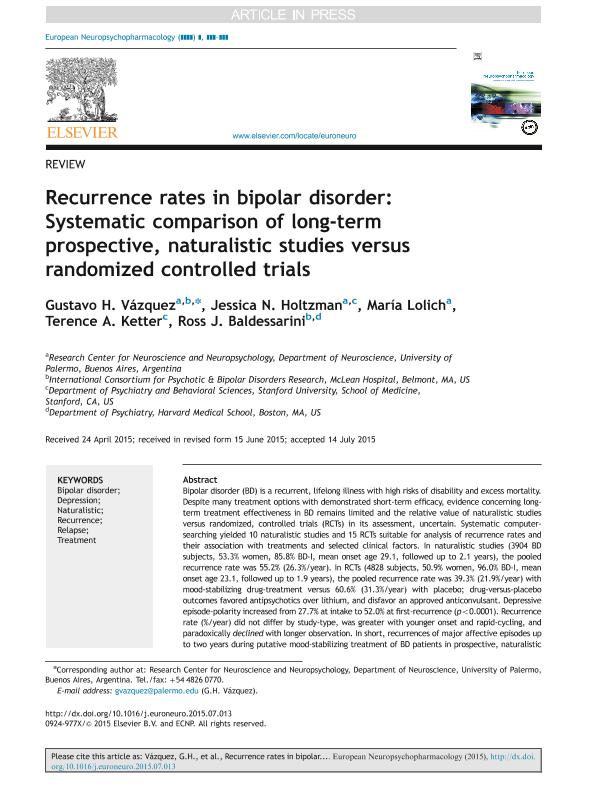Mostrar el registro sencillo del ítem
dc.contributor.author
Vázquez, Gustavo H.
dc.contributor.author
Holtzman, Jessica N.
dc.contributor.author
Lolich, Maria

dc.contributor.author
Ketter, Terence A.
dc.contributor.author
Baldessarini, Ross J.

dc.date.available
2018-04-16T17:41:52Z
dc.date.issued
2015-10
dc.identifier.citation
Vázquez, Gustavo H.; Holtzman, Jessica N.; Lolich, Maria; Ketter, Terence A.; Baldessarini, Ross J.; Recurrence rates in bipolar disorder: Systematic comparison of long-term prospective, naturalistic studies versus randomized controlled trials; Elsevier Science; European Neuropsychofarmacology; 25; 10; 10-2015; 1501-1512
dc.identifier.issn
0924-977X
dc.identifier.uri
http://hdl.handle.net/11336/42151
dc.description.abstract
Bipolar disorder (BD) is a recurrent, lifelong illness with high risks of disability and excess mortality. Despite many treatment options with demonstrated short-term efficacy, evidence concerning long-term treatment effectiveness in BD remains limited and the relative value of naturalistic studies versus randomized, controlled trials (RCTs) in its assessment, uncertain. Systematic computer-searching yielded 10 naturalistic studies and 15 RCTs suitable for analysis of recurrence rates and their association with treatments and selected clinical factors. In naturalistic studies (3904 BD subjects, 53.3% women, 85.8% BD-I, mean onset age 29.1, followed up to 2.1 years), the pooled recurrence rate was 55.2% (26.3%/year). In RCTs (4828 subjects, 50.9% women, 96.0% BD-I, mean onset age 23.1, followed up to 1.9 years), the pooled recurrence rate was 39.3% (21.9%/year) with mood-stabilizing drug-treatment versus 60.6% (31.3%/year) with placebo; drug-versus-placebo outcomes favored antipsychotics over lithium, and disfavor an approved anticonvulsant. Depressive episode-polarity increased from 27.7% at intake to 52.0% at first-recurrence (p<0.0001). Recurrence rate (%/year) did not differ by study-type, was greater with younger onset and rapid-cycling, and paradoxically declined with longer observation. In short, recurrences of major affective episodes up to two years during putative mood-stabilizing treatment of BD patients in prospective, naturalistic studies and RCTs were substantial and similar (26.3 vs. 21.9%/year). Episode-polarity shifted strongly toward depressive first-recurrences. These findings support the value of naturalistic studies to complement long-term RCTs, and add to indications that control of depression in BD remains particularly unsatisfactory.
dc.format
application/pdf
dc.language.iso
eng
dc.publisher
Elsevier Science

dc.rights
info:eu-repo/semantics/openAccess
dc.rights.uri
https://creativecommons.org/licenses/by-nc-nd/2.5/ar/
dc.subject
Bipolar Disorder
dc.subject
Depression
dc.subject
Naturalistic
dc.subject
Relapse
dc.subject.classification
Salud Ocupacional

dc.subject.classification
Ciencias de la Salud

dc.subject.classification
CIENCIAS MÉDICAS Y DE LA SALUD

dc.title
Recurrence rates in bipolar disorder: Systematic comparison of long-term prospective, naturalistic studies versus randomized controlled trials
dc.type
info:eu-repo/semantics/article
dc.type
info:ar-repo/semantics/artículo
dc.type
info:eu-repo/semantics/publishedVersion
dc.date.updated
2018-04-12T14:30:49Z
dc.journal.volume
25
dc.journal.number
10
dc.journal.pagination
1501-1512
dc.journal.pais
Países Bajos

dc.journal.ciudad
Amsterdam
dc.description.fil
Fil: Vázquez, Gustavo H.. Universidad de Palermo; Argentina. McLean Hospital; Estados Unidos
dc.description.fil
Fil: Holtzman, Jessica N.. Universidad de Palermo; Argentina. University of Stanford; Estados Unidos
dc.description.fil
Fil: Lolich, Maria. Universidad de Palermo; Argentina. Consejo Nacional de Investigaciones Científicas y Técnicas; Argentina
dc.description.fil
Fil: Ketter, Terence A.. University of Stanford; Estados Unidos
dc.description.fil
Fil: Baldessarini, Ross J.. McLean Hospital; Estados Unidos. Harvard Medical School; Estados Unidos
dc.journal.title
European Neuropsychofarmacology

dc.relation.alternativeid
info:eu-repo/semantics/altIdentifier/doi/http://dx.doi.org/10.1016/j.euroneuro.2015.07.013
dc.relation.alternativeid
info:eu-repo/semantics/altIdentifier/url/https://www.sciencedirect.com/science/article/pii/S0924977X1500231X
Archivos asociados
